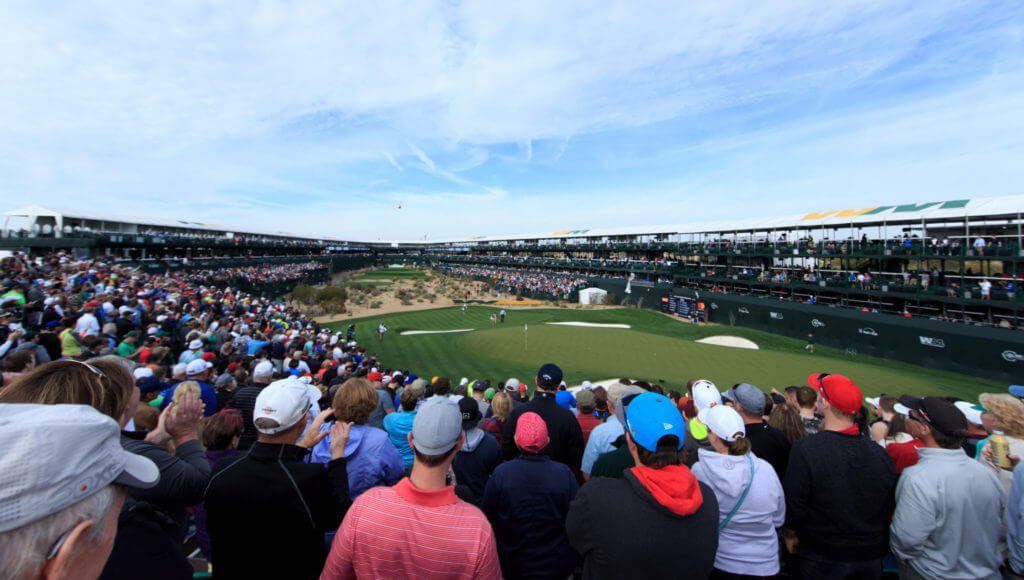
SCOTTSDALE, Ariz. — For 51 weeks a year, the par-3 16th hole at TPC Scottsdale is quite boring. It’s only a short-iron shot to a fairly large green surrounded by fairly innocuous bunkers. For a PGA Tour pro, that typically results in a good look at birdie nine out of 10 times.
It gets far more stressful, however, when the Waste Management Phoenix Open sets up its de facto football stadium that fits upwards of 20,000 screaming fans around the course’s shortest hole. It’s a madhouse that only gets louder as the day progresses.
A poor shot will earn boos. Even a decent shot could earn you some boos.
“It used to be that if you missed the green, the fans would boo,” says J.J. Jakovac, Ryan Moore’s caddie. “But now if you hit it to 35 feet, they still aren’t happy.
That places plenty of pressure on not just the players hitting the shot, but the caddies as well. The club selection, strategy and overall mindset has to be right going into the hole or else a player could talk himself into a bad swing.
So what are the tricks of the trade to caddying for golf’s loudest hole?
The first pro tip nearly every caddie mentions, and this may be the most important one of all, is that you can’t wait until the 16th tee to gauge the wind. A little counterintuitive, right? The problem is that the grandstands surrounding the hole block the wind not unlike if you were to play a tree-lined course. Standing on the island green of the par-5 15th is the best opportunity to get an accurate reading.
“You start thinking about it on the 15th green,” says John Wood, Matt Kuchar’s caddie. “You have to read the wind there because once you get into that little stadium, you can’t tell a thing. You can guess but you really don’t know.”
Next on the list is attempting to manage adrenaline. Most of the caddies say that you can count on your player hitting the ball about 4-5 yards farther than normal. It’s also worth noting that the Phoenix area is about 1,000 feet above sea level and the ball tends to stay in the air a little longer compared to a course near sea level like Torrey Pines. It’s 163 yards on the scorecard but almost never plays more than 150.
HOT READ: How an email landed Geno Bonnalie his gig as a PGA Tour caddie
With the wind and yardage sorted out, the next step is club selection. The toughest hole location is in the back left corner of the green — missing left of the green here is deadly. If the hole location is in the front of the green, it’s usually easier to attack.
But that doesn’t mean you should take dead aim. Hitting the center of the green is a safe shot and it often leaves the player with a makeable birdie putt.
“We were joking the other day that it’s either a 9-iron or a 9-iron,” says Casey Clendenon, caddie for Chris Stroud. “There’s nothing else you need to hit, just get yourself into the center of the green and don’t even think about going for flags on the edges. The last thing you want is to be booed off the tee.”
The technical aspects of caddying aside, the hole’s atmosphere is difficult to beat. During Wednesday’s pro-am, the stands are full and the music is blaring so loud you can hear it across the property. There’s no music come Thursday morning, but the electricity only continues to climb.
“When you walk through that tunnel, your heart is pounding,” says Clendenon.
Emerging from the tunnel, the nerves are flowing and one thing that is almost never a problem in golf — communication — becomes difficult. There’s a constant hum in the crowd. Marshals aren’t necessary.
“It’s really weird because they say ‘quiet please’ but you can barely hear the guy next to you once you stand on the tee,” says Jakovac. “It’s the only hole I’ve ever been on where you actually can’t hear impact.”
The caddies enjoy the spectacle and it’s certainly a unique challenge to get their guy prepared to hit the shot, but it’s not something they want to do every hole or even every round.
The 16th is a different animal for caddies. That’s occasionally a good thing.
“I’m not sure I would want to do it all the time,” says Wood. “But it’s fun as heck once per year.”